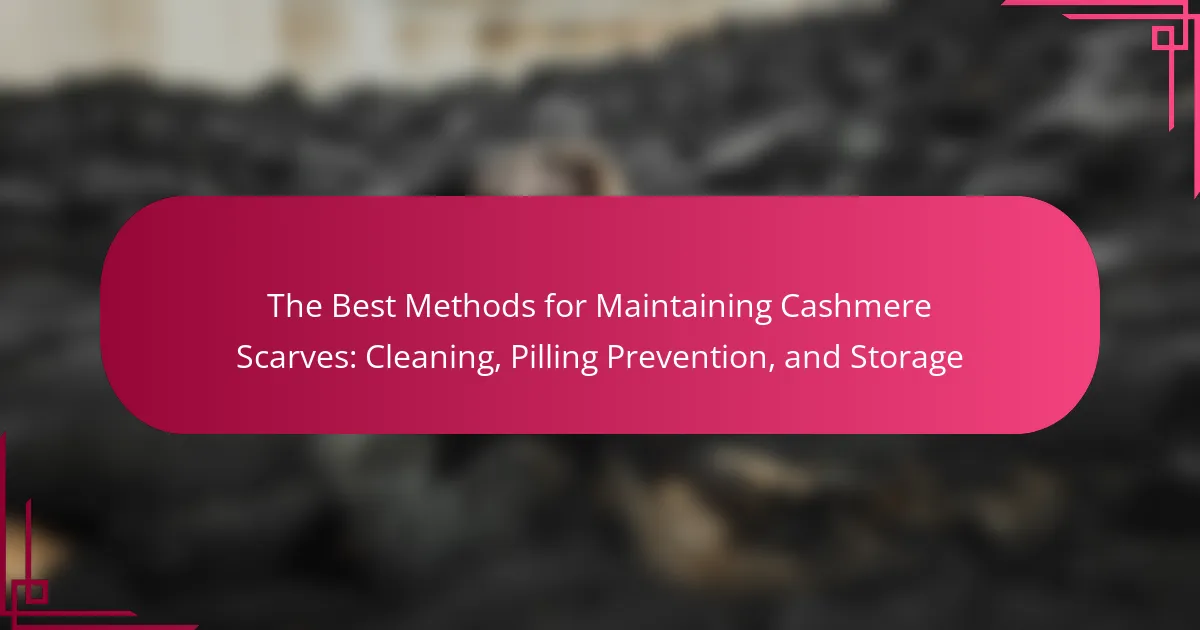Cashmere scarves are luxurious accessories that require specific care to maintain their quality and longevity. The article outlines the best methods for cleaning, pilling prevention, and storage of cashmere scarves. Key recommendations include hand washing in cold water with mild detergent, proper drying techniques to avoid stretching, and storing scarves in breathable cotton bags away from sunlight and humidity. Additionally, regular de-pilling using a cashmere comb or fabric shaver is advised to preserve softness. Following these guidelines ensures that cashmere scarves remain in excellent condition over time.

What are the Best Methods for Maintaining Cashmere Scarves?
The best methods for maintaining cashmere scarves include gentle washing, proper drying, and careful storage. Hand washing in cold water with a mild detergent is recommended. Avoid using hot water or harsh chemicals, as they can damage the fibers. Rinse thoroughly to remove all detergent. Lay the scarf flat on a clean towel to dry, reshaping it to its original form. Avoid hanging, as this can stretch the fabric. Store cashmere scarves folded in a breathable cotton bag. Keep them away from direct sunlight and humidity to prevent deterioration. Regularly de-pill using a cashmere comb or a fabric shaver to maintain softness. Following these methods ensures the longevity and quality of cashmere scarves.
How do cleaning methods affect the longevity of cashmere scarves?
Cleaning methods significantly impact the longevity of cashmere scarves. Gentle cleaning methods, such as hand washing or using a delicate cycle, preserve the fibers better than harsh machine washing. Using cold water and mild detergents protects the natural oils in cashmere. Avoiding bleach and fabric softeners prevents damage to the delicate fibers. Air drying is preferable over machine drying, as heat can cause shrinkage and loss of shape. Regular cleaning helps prevent dirt buildup, which can weaken fibers over time. Proper cleaning techniques can extend the lifespan of cashmere scarves by maintaining their softness and structure.
What are the recommended cleaning techniques for cashmere scarves?
The recommended cleaning techniques for cashmere scarves include hand washing and dry cleaning. Hand washing involves using cold water and a gentle detergent specifically designed for delicate fabrics. It is essential to avoid wringing or twisting the scarf to prevent damage. Instead, gently press the water out and lay the scarf flat on a clean towel to dry. Dry cleaning is another effective method, especially for heavily soiled items. Reputable dry cleaners can safely clean cashmere without risking shrinkage or loss of softness. These techniques help maintain the quality and longevity of cashmere scarves.
How often should cashmere scarves be cleaned?
Cashmere scarves should be cleaned every 4 to 6 wears. This frequency helps maintain the fabric’s softness and prevents damage. Cashmere is a delicate material that can lose its luster if over-washed. Spot cleaning is recommended for minor stains. Hand washing in cold water with mild detergent is ideal. Dry cleaning is also an option but should be limited to preserve the fibers. Regular cleaning prevents odors and keeps the scarf looking fresh.
What are the essential practices for preventing pilling on cashmere scarves?
To prevent pilling on cashmere scarves, follow specific essential practices. First, always wash cashmere scarves in cold water. Use a gentle detergent designed for delicate fabrics. Avoid using fabric softeners, as they can contribute to pilling. When drying, lay the scarf flat on a clean towel. Do not hang it to dry, as this can stretch the fibers. Store cashmere scarves folded, not hanging. This reduces friction that can cause pilling. Additionally, avoid wearing a cashmere scarf with rough materials. This helps minimize abrasion. Regularly remove any pills with a cashmere comb or a fabric shaver. This keeps the scarf looking fresh and new.
What causes pilling on cashmere scarves?
Pilling on cashmere scarves is caused by friction and wear. When cashmere fibers rub against themselves or other materials, they can break and tangle. This process leads to the formation of small balls of fiber, known as pills. Factors such as rough surfaces, frequent movement, and improper washing can exacerbate pilling. Additionally, lower-quality cashmere may be more prone to pilling due to shorter fibers. Research shows that cashmere with longer, stronger fibers is less likely to pill. Proper care, including gentle washing and storage, can help reduce the occurrence of pilling.
How can pilling be effectively minimized?
Pilling can be effectively minimized by following specific care practices. Regularly brushing cashmere with a soft garment brush removes loose fibers. Washing cashmere in cold water reduces friction that causes pilling. Using a gentle detergent designed for delicate fabrics helps maintain the fiber’s integrity. Storing cashmere flat, rather than hanging, prevents stretching and pilling. Avoiding fabric softeners, which can damage fibers, is crucial. Lastly, selecting high-quality cashmere reduces the likelihood of pilling, as finer fibers are less prone to this issue.
What is the best way to store cashmere scarves?
The best way to store cashmere scarves is to fold them neatly and place them in a breathable cotton or linen bag. This method prevents creasing and helps maintain the scarf’s shape. Avoid hanging cashmere scarves, as this can stretch the fibers over time. Ensure the storage area is cool and dry to prevent moisture damage. Using cedar blocks or lavender sachets can deter moths, which are attracted to cashmere. Regularly check the stored scarves for any signs of pests or damage. Proper storage can significantly extend the lifespan of cashmere scarves.
What storage conditions are ideal for cashmere scarves?
Cashmere scarves should be stored in a cool, dry place. Ideal temperatures range between 60°F to 70°F. Humidity levels should be low to prevent mold and mildew. It’s best to avoid direct sunlight to prevent fading. Storing cashmere scarves flat is recommended to maintain their shape. Use breathable fabric bags for added protection. Avoid plastic bags, as they can trap moisture. Regularly check for pests, as they can damage cashmere. These conditions help preserve the quality and longevity of cashmere scarves.
How can proper storage extend the life of cashmere scarves?
Proper storage can significantly extend the life of cashmere scarves. Storing cashmere in a cool, dry place prevents moisture damage and mold growth. Folding cashmere instead of hanging it prevents stretching and maintains its shape. Using breathable fabric bags allows air circulation, reducing the risk of mustiness. Avoiding direct sunlight prevents color fading and deterioration of fibers. Regularly checking for pests protects against damage from moths and other insects. These practices collectively help maintain the integrity and appearance of cashmere scarves over time.
How do cleaning, pilling prevention, and storage interrelate?
Cleaning, pilling prevention, and storage are interconnected in maintaining cashmere scarves. Proper cleaning removes dirt and oils that can contribute to pilling. Regular cleaning helps maintain the scarf’s appearance and texture. Pilling occurs when fibers rub against each other, often exacerbated by dirt. Preventing pilling involves using gentle cleaning methods and avoiding harsh detergents. Storing cashmere correctly is essential after cleaning. Proper storage minimizes friction and protects the fabric from damage. Using breathable bags and avoiding overcrowding helps maintain the scarf’s condition. Together, these practices ensure the longevity and quality of cashmere scarves.
What are the common mistakes to avoid when maintaining cashmere scarves?
Common mistakes to avoid when maintaining cashmere scarves include improper washing techniques. Using hot water can shrink and damage cashmere fibers. Additionally, using harsh detergents can strip the natural oils from the fabric. Avoiding machine drying is crucial, as it can lead to deformation. Storing cashmere scarves improperly, such as hanging them, can cause stretching. Not using a breathable storage bag can expose scarves to moths and dust. Neglecting to remove pilling can make the scarf look worn and old. Finally, failing to follow care label instructions can result in irreversible damage.
How can improper cleaning damage cashmere scarves?
Improper cleaning can damage cashmere scarves by causing shrinkage and loss of softness. Cashmere fibers are delicate and can be easily affected by harsh detergents. Using hot water can lead to felting, which makes the fabric lose its luxurious texture. Additionally, aggressive washing methods can result in pilling, where small balls of fiber form on the surface. Drying cashmere scarves in direct sunlight can also fade the color and weaken the fibers. Therefore, using gentle cleaning methods is crucial to preserve the integrity of cashmere.
What storage errors can lead to deterioration of cashmere scarves?
Improper storage can lead to deterioration of cashmere scarves. Storing cashmere in humid environments can cause mold and mildew growth. Exposure to direct sunlight can fade the color and weaken the fibers. Folding instead of rolling can create creases that damage the fabric. Using plastic bags traps moisture and promotes mildew. Storing cashmere with mothballs can lead to chemical damage. Neglecting to clean scarves before storage can attract pests. Lastly, overcrowding storage spaces can lead to crushing and misshaping the scarves.
What are the best tips for maintaining cashmere scarves effectively?
To maintain cashmere scarves effectively, follow specific care guidelines. Hand wash cashmere in lukewarm water with a gentle detergent. Rinse thoroughly to remove all soap residue. Avoid wringing or twisting the fabric, as this can damage fibers. Lay the scarf flat on a clean towel to dry. Reshape it to its original size while damp. Store cashmere scarves folded in a cool, dry place. Use breathable storage bags to prevent moth damage. Regularly brush the scarf with a cashmere comb to remove pilling. These practices extend the life and appearance of cashmere scarves.
The main entity of this article is cashmere scarves, focusing on their maintenance through effective cleaning, pilling prevention, and proper storage techniques. Key methods for maintaining cashmere include hand washing with mild detergents, air drying, and storing in breathable bags to prevent damage. The article emphasizes the importance of gentle cleaning to extend the lifespan of cashmere by avoiding harsh chemicals and high temperatures. Additionally, it addresses common mistakes to avoid, such as improper washing and storage practices that can lead to deterioration. Overall, following these guidelines ensures the longevity and quality of cashmere scarves.
